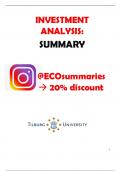INVESTMENT
ANALYSIS:
SUMMARY
@ECOsummaries
→ 20% discount
1
,Table of contents
Week 1_________________________________________________page 3-10
Week 2_________________________________________________page 11-14
Week 3_________________________________________________page 15-21
Week 4_________________________________________________page 22-26
Week 5_________________________________________________page 27-29
Week 6_________________________________________________page 30-33
Week 7_________________________________________________page 34-36
Week 8_________________________________________________page 37-44
Week 9_________________________________________________page 45-47
2
,Week 1 – investment environment, trading securities, financial crisis & funds
Investment environment
Assets:
Real assets: used to produce goods/services (land, building, machines)
Financial assets: claim on real assets (stocks/bonds)
Indifference curves:
- Points on different curves yield the same utility, you
must look at the most rightwards function to get the
optimal.
- Point D gives the highest utility
Investment process:
Asset allocation: choosing whether to invest in bonds, ETFs, stocks, etc.
Security selection: choosing what specific securities to choose within the asset class of bonds,
ETFs, stocks, etc.
Top-down: asset allocation → pick securities
Bottom up: pick securities without much concern for asset allocation
Active management: finding securities handpicked and ‘timing’ the market.
→ Higher trading and management costs
Passive management: highly diversified portfolio without ‘timing’ the market (ETFs).
→ Lower trading and management costs
Players in the field:
Investment banks: perform services for firms (IPO), handle marketing of securities in primary
market, seasonal equity offering (SEO): done by existing publicly traded firms to raise extra
equity.
Venture capital: management and investing of start-ups.
Private equity: investment in not publicly traded firms.
3
, Financial markets:
Money markets: short term, liquid, low risk
- Treasury bills
- Euro / dollars
- Certificates of deposits
- LIBOR: short-term interest rate in Euro money market
- Etc.
Bond market:
- Treasury notes and bonds
- Corporate bonds
- Municipal bonds
- Mortgage securities
- Federal agency debt
Capital markets: long term, riskier
- Common stock:
* Voting rights, residual claim to assets/income, limited liability, dividend + capital gains
- Preferred stock:
* No voting rights, fixed amount of income, obligation to pay interest but not dividend.
Derivative markets: trading of derivative assets
- Derivative asset: claim whose value is contingent on the value of underlying asset.
* Options: right to buy/sell, purchased, only exercise when profitable
* Futures: obligation to buy/sell, entered without purchasing, obligation to buy/sell at futures
prices.
4





